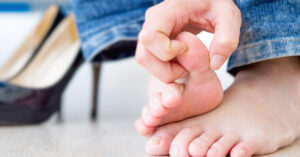Tiny Bones, Big Pain: Understanding Sesamoids
July 18 2025
Dealing with nagging foot pain? Those tiny sesamoid bones under your big toe could be the culprits! Don’t let discomfort hold you back – learn how a podiatrist can help get you back on your feet and pain-free!
The human foot is a marvel of engineering, a complex interplay of bones, ligaments, tendons, and muscles that bear our weight and propel us through life. Within this intricate structure lie two small, yet incredibly significant, bones often overlooked until they become a source of pain: the sesamoids. As a podiatrist, I’ve seen firsthand the impact these diminutive bones can have on a person’s mobility and quality of life, and it’s a topic I believe warrants far greater attention
What are Sesamoids and What Do they Do?
Sesamoids are unique because, unlike most bones, they are not directly connected to other bones via a joint. Instead, they are embedded within tendons. In the foot, the two primary sesamoid bones are located on the plantar (bottom) surface of the forefoot, beneath the head of the first metatarsal bone (the long bone leading to your big toe). They are nestled within the flexor hallucis brevis tendon, which helps to flex the big toe.
Think of the as tiny pulleys. Their primary function is to provide a smooth surface for the tendons to glide over, increasing the mechanical advantage of the muscles that control the big toe, crucial for push-off during walking, running, and jumping. They also help to distribute weight evenly across the ball of the foot and protect the underlying tendons from excessive friction and pressure.

When Sesamoids Cause Trouble
Despite their small size, sesamoids are subject to immense forces with every step we take. This makes them vulnerable to a range of conditions, collectively known as sesamoiditis. Sesamoiditis is essentially an inflammation of the sesamoid bones and the surrounding tendons. It’s often an overuse injury, common in athletes, dancers, and anyone who places repetitive stress on the balls of their feet,
The symptoms of sesamoiditis typically include pain directly beneath the big toe joint, which often worsens with activity and improves with rest. There may also be swelling, tenderness to the touch, and difficulty bending or straightening the big toe. Patients often describe the pain as a dull ache that can escalate to a sharp, throbbing sensation. In some cases, a stress fracture of the sesamoid bone can occur, leading to more intense and persistent pain. Less commonly, osteonecrosis (death of bone tissue due to lack of blood supply) can affect the sesamoids, a serious condition requiring prompt medical attention.
Treatment Approaches for Sesamoid Pain
Treatment for sesamoiditis is typically conservative and ims to reduce pain and inflammation. Rest is paramount – often meaning a temporary reduction or cessation of activities that exacerbate the pain. Ice application can help reduce swelling. Over-the-counter anti-inflammatroy medications like ibuprofen can also provide relief.
One of the most crucial aspects of treatment is offloading the affected area. This can be achieved through various means:
Padding and Taping: Strategic padding can redistribute pressure away from the sesamoids. Taping the big toe can also limit its movement and reduce stress.
Orthotics: Custom-made orthotics with specific modifications, such as metatarsal pad or a cut-out beneath the sesamoids, are incredibly effective in providing support and cushioning, thus reducing pressure on these delicate bones.
Supportive Footwear: Choosing shoes with a wide toe box and good cushioning can significantly alleviate symptoms. High heels and shoes with thin soles should be avoided.
In more persistent cases, corticosteroid injections may be considered to reduce inflammation. Physical therapy can also play avital role in strengthening the surrounding muscles and improving biomechanics to prevent recurrence. Surgery to remove a sesamoid bone (sesamoidectomy) is a last resort, reserved for cases that haven’t responded to extensive conservative treatment and when a fracture or osteonecrosis is present.
Prevention is Key
Preventing sesamoiditis largely revolves around proper footwear, gradual increases in activity levels, and addressing any underlying biomechanical imbalances. Athletes, in particular, should ensure their training programs include adequate rest and recovery periods.
The sesamoids, though small, are mighty. When they hurt, they can make every step a painful ordeal, impacting your ability to walk, run, and enjoy an active life. As a podiatrist, my goal is to help you understand these often-misunderstood bones and provide comprehensive care to get you back on your feet comfortably and confidently.
 If you are experiencing pain under the ball of your foot, especially near your big toe, don’t ignore it. Early diagnosis and treatment are key to preventing chronic issues. Schedule an appointment with a podiatrist today to have your symptoms evaluated and receive a personalized treatment plan. Your feet work hard for you – it’s time to give them the care they deserve.
If you are experiencing pain under the ball of your foot, especially near your big toe, don’t ignore it. Early diagnosis and treatment are key to preventing chronic issues. Schedule an appointment with a podiatrist today to have your symptoms evaluated and receive a personalized treatment plan. Your feet work hard for you – it’s time to give them the care they deserve.
If you are experiencing foot pain which may be sesamoids, contact Dr. Altepeter’s office at (239) 430-3668 (FOOT) or visit www.NaplesPodiatrist.com to schedule your appointment online.
Serving Southwest Florida Since 2005, Family Foot & Leg Center has 9 convenient locations throughout Collier, Lee, Charlotte, and Sarasota Counties. Offering pediatric to geriatric family care: Ingrown Toenails, Heel Pain, Bunions, Foot / Ankle Arthritis Pain, Plantar Fasciitis, Foot / Ankle Surgery, Custom Orthotics, and Diabetic Wound Care. In office X-rays, ultrasounds, and minor surgical suite exam rooms. Practice powered by EMR and advanced technologies.
Home of the Lam Minimally Invasive No-Scar Bunion Surgery! Come Discover Why Patients Love Our 5-Star Foot & Ankle Care!
Same Day Appointments! Easy Online Appointment Scheduling.

 Fax: (239) 692-9436
Fax: (239) 692-9436 Tel: 239-430-3668
Tel: 239-430-3668